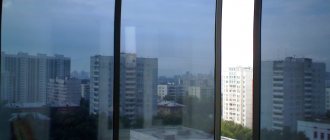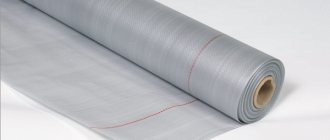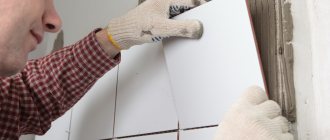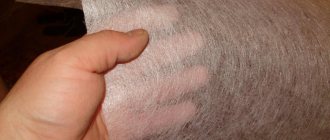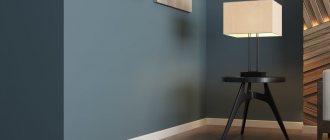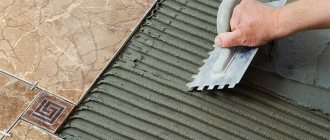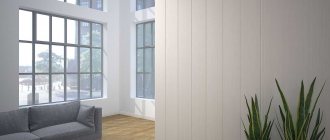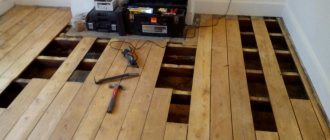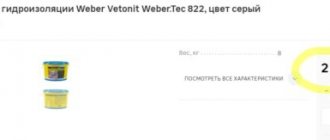When you need to quickly and inexpensively update the interior of your bathroom, self-adhesive bathroom film comes to the rescue. This is a budget solution, and at the same time the material allows you to realize various design ideas. Where film is used, its types, advantages and disadvantages, as well as installation rules are discussed in this article.
Features and types of material
The decision to cover the walls with self-adhesive film should be deliberate. What are the features of this solution:
- Economical.
- Environmentally friendly. Does not contain harmful chemicals.
- Fire resistance. The components of the composition do not ignite.
- Water resistance. Resistant to moisture. Apartments with unstable humidity levels and temperature changes render wall coverings unusable. Such troubles do not happen with film.
Attention! The last advantage becomes a disadvantage when the self-adhesive film is glued to a cold wall. A temperature difference is formed. Moisture condenses between the wall and the coating.
Divided into types:
- Functional – insulating, protective.
- Designer.
Advantages of film when finishing wet rooms
Self-adhesive film for bathroom finishing
Bathroom film is far from the only cladding option. Panels, cork, wallpaper, tiles - all products are in demand and are suitable for finishing both bathrooms and other areas of the apartment. But despite high quality standards, the materials have one drawback - price! The cost of tiles is incomparable with the price of wallpaper, and they, in turn, are valued much higher than bathroom film. In addition, the speed of pasting surfaces is much faster, and the possibilities of the film are simply enormous! You need to turn an old cabinet into a decent piece of furniture or make a nice pattern on the doors - bath film will come in very handy.
- Affordable price.
- Large and varied range of colors.
- Fast process of facing work without the involvement of third parties.
- Easy to care for.
- Nice appearance.
Vinyl film for the bathroom meets all these points.
Advice! If you choose wallpaper for decoration, pay attention to the pictograms embossed on the back of the material or on the shell of the roll. One wave is moisture resistant, two waves are washable, three waves are super washable. Brush and one wave – easy cleaning with a brush and available detergents. Brush and three waves - excellent resistance to mechanical damage (such wallpaper can be cleaned using abrasives, the fractions of which are not large in size).
Principles of material classification
Self-adhesive film is versatile and varied. It is a multifunctional material that is classified according to different parameters, which allows you to choose the ones you need. Self-adhesive is divided according to properties, material, structure, type of surface on which it can be glued. There is also a classification according to purpose: protective, serving as a shield or decorative.
Interesting! Self-adhesive film is often the most economical solution when decorating a room. Usually its price is less than that of wallpaper or other coverings. Additions to the average price occur as a markup for the manufacturer's brand or additional functions. A beautiful designer one with a protective function is more expensive than a simple decorative one.
Types of self-adhesive film according to the material used in production
Various substances are used in production. Self-adhesive does not consist of one component. They are combined to obtain different properties. The main components are polyester, propylene, polyvinyl chlamide. Often contains paper or cloth. These additives make the structure and appearance similar to conventional wallpaper.
Classification of self-adhesive film by structure
Structural classification refers to the number of layers. It happens:
- Single layer. The simplest one is “standard”. It can be hard or elastic, it depends on the composition. The production process is similar to making paper - from a “substance” to which dyes, base, and fastening elements are added. The final product is obtained by pressing and drying. It is supplied in rolls to distributors.
- Double layer. With a more complex structure. It costs no more than a single layer. It's more convenient to work with her. The layers are called "base" and "cover". The base is a single-layer structure, the cover is a part made of resin of different consistency. Because of this layer, it is more elastic, and “wrinkling” does not form on the surface with the design. You have to pay for convenience: in technical terms, the two-layer structure of the self-adhesive coating is inferior to the single-layer one.
Double layer transparent
Important! To decide which self-adhesive film to choose, first understand where it will be used and what is planned to be obtained from its use. Having figured it out, you can choose the material and count on a long service life.
By surface type
The type of surface that the finishing material creates is also important when implementing design solutions. Need to enlarge your room? Lighten? Create a special impression?
- Matte. For rooms with good lighting. The walls don't shine. If properly applied, it can pass for paint or wallpaper.
Matte
- Glossy. For rooms with poor lighting or lovers of “glitz and chic”. The surface shines but does not reflect light.
Glossy
- Mirror. Regardless of the lighting, it looks beautiful. Visually expands the room. Different colors will help create the mood.
- Transparent. Mirrors and transparent surfaces can be covered with transparent self-adhesive to protect against minor damage - scratches, abrasions.
- Holographic. Creates an unusual effect on any surface. Often with fancy patterns.
Holographic
Self-adhesive film as wallpaper for wall decoration
Wallpaper remains a popular type of wall decoration compared to other solutions. The reason is the wide choice of design options. Colors and designs are chosen by customers depending on current needs.
Many manufacturers have recently launched the production of self-adhesive wallpaper. On one side of the material there is a decorative part, the other side is covered with special paper, which will be adhesive. This means that the master does not need to waste time preparing the solution and searching for suitable components. There is no need to purchase additional tools. There are no additional requirements for the premises where the work is carried out.
The type for sale is rolls, 40-90 centimeters wide, 14 m long. Usually this is a finishing material that is often used for the restoration of various surfaces.
The master does not need to waste time preparing the solution and searching for suitable components.
Features of the material, main advantages and disadvantages of use
Self-adhesive film for walls has almost no disadvantages. The only thing is the likelihood of a small thickness, which is why most defects are immediately visible on the surface. Therefore, the original surface places high demands on its arrangement.
The list of advantages is impressive:
- Low cost, allowing for various experiments.
- Versatility with a wide range of applications.
- Various designs and textures. There are even varieties with photo printing available.
- Health safety during installation and further operation.
- Wear resistance combined with strength and durability.
- Protection against temperature changes, too low and too high values equally.
- UV protection.
- Moisture resistance.
- Self-adhesive wall film is used even in bathrooms and kitchens.
There are even varieties with photo printing available.
Where is self-adhesive film used?
The range of uses of the innovative solution is wide. The main methods have long been known.
- Complete wall covering. The walls are covered with one (or different) types of self-adhesive coating. An excellent option is to use interesting design drawings. For bathrooms - prints with shells or images of the beach. For bedrooms - with stars or sky. The solution is limited by imagination.
- On parts of the walls. Figured images - a world map or an interesting solution like “puddles” on the wall. You can apply self-adhesive strips. They are popular in children's rooms and living rooms. This is how imitations of columns are created.
- For furniture. To update your furniture, you don't have to buy new ones. Old cabinets, stools, and tables can be covered with a printed self-adhesive coating, giving the items a new life. Get rid of the feeling of boredom and routine.
For furniture
- For work surfaces. Near kitchen tables, stoves, and sinks, a different wall covering is often used. This is done to make maintenance easier. You can use film. It fits the required parameters perfectly. Not afraid of water, fire, easy to care for.
- For windows. Let's remember car tinting - what is it? Film. Self-adhesive material is applied to the windows of houses and apartments for tinting, obtaining soft lighting, and eliminating glare.
Self-adhesive wallpaper for the kitchen and bathroom: varieties
- Cork wallpaper. They are made of artificial materials, have a wax coating, and look like natural cork. They will last a very long time (up to 20 years). They keep the room warm and do not muffle extraneous sounds. They do not change their appearance and are antistatic.
- Self-adhesive polyvinyl chloride film. It has excellent stretch and is very durable. Sold in one tone or with a pattern, matte, glossy. It is used to paste over walls, furniture, and door frames.
- Adhesive based photo wallpaper.
- Satin self-adhesive wallpaper imitates fabric.
- Film with a special coating. You can make a drawing on it with chalk or a marker.
- Self-adhesive wallpaper imitating wood, brick, marble, leather.
First you need to choose the shade and pattern of the material so that it matches other details of the bathroom and kitchen.
A bathroom covered with a material of the same color with a slightly rough surface looks good. You can choose prints with a seascape.
Self-adhesive film can be used to glue not only bathroom walls, but also pipes
Advantages
People choose self-adhesive film as a finish because it has the following advantages:
- After gluing, it will protect the walls from water getting on them.
- It easily replaces washable vinyl wallpaper.
- Can withstand high temperatures (up to 80°C).
- Calmly tolerates sudden changes in air temperature.
- Excellent adhesion to various walls: wood, plaster, metal, plasterboard, glass.
- They sell a variety of materials, it can be matte and glossy, plain and patterned, pastel and bright shades, it can imitate wood or brick.
- It is easy to attach to the surface, no glue required.
- It has good performance qualities.
- Its maintenance is minimal.
- It is cheap and always available in stores.
True, it also has disadvantages:
- It will last in the bathroom for approximately 3 years.
- Its surface is not breathable, so air does not reach the wall. Therefore, condensation and mold may appear on the wall. Because of this, before attaching the material, it is worth treating the surfaces with a primer that has the necessary properties.
How to glue self-adhesive film with your own hands: steps
Finishing can be done without proper experience. It will look quite professional. First you need to prepare everything you need:
- material;
- stationery knife;
- measuring tool - construction ruler or tape measure;
- putty knife;
- pencil.
Interesting! You can use a hairdryer while working. Heating makes the coating elastic and simplifies other processes.
The pasting process itself is simple.
- The surface is prepared using any possible method and material.
- A piece of covering is cut off. When completely pasted, a strip of the required length is cut from the roll.
- The protective layer is removed, and the coating is attached to the wall from top to bottom. For a tight fit, without bubbles, level with a spatula.
Pasting
On what surface is pasting allowed?
Pasting is possible on a prepared surface. A wall (or any other surface) has been prepared, where:
- Irregularities have been smoothed out - scratches, chips, dents have been removed, bumps have been sanded.
- No contamination - dust, dirt, etc.
- Treated with a special solution - primer, antiseptic or something else (depending on the material from which the surface is made).
When not to glue
Pasting on an unprepared wall is impossible if it is uneven, has chips/dents/bumps, or the self-adhesive will not lie flat - bubbles will form. Pasting a “cold” wall is unacceptable. Otherwise, condensation cannot be avoided, which will lead to the coating peeling off.
How to stick on a flat wall
The sticker is applied to a flat surface according to the instructions given. This is not difficult if the surface is prepared in advance. A little diligence in leveling is all it takes.
How to properly glue in corners
The corners are covered with overlap, this way you can avoid the formation of folds and inconsistencies that will spoil the picture.
Features of choice for the bathroom
You can purchase rolls with widths from 45 cm to 90. The length of the roll can be from 2 m to 15 m. The material can have a pastel shade or be bright, with a pattern or ornament. There are both glossy and matte materials, smooth or rough. It can simulate:
- tapestry;
- stone;
- tree;
- textile;
- ceramics;
- canvas;
- mirror, gold and silver surface.
Material that has a fluorescent effect may be sold.
When purchasing a bath film, you should carefully read the instructions. Only material that can withstand high humidity is suitable.
The marking is made in the form of waves: 1 wave means moisture resistance, 2 waves - that it can be washed, 3 waves - that it can be washed with any composition. If a brush and 1 wave are drawn, then the material can be wiped with a soft brush and gentle detergents. If the brush has 3 waves, then it is difficult to damage it mechanically; it can be cleaned with fine abrasive agents.
How to stick self-adhesive film on the walls in the bathroom?
When it comes to finishing a self-adhesive bathroom, many remodelers are perplexed. How to glue something in the bathroom? It's like wallpaper. Who wallpapers a bathroom?
The film is waterproof. It is suitable for bathrooms, saunas, swimming pools. If you look closely, you will notice that it has been used in public institutions for a long time. It is important to choose a material of the desired density, elasticity, and design. For the bathroom, you should choose an option that contains less paper.
Interesting! The self-adhesive tape must be applied to a dry surface. It will “stick tightly”; no moisture will be afraid of it.
There is another compelling argument for film coating in the bathroom - it is made of materials that do not contribute to rotting or mold.
In bathroom
In what rooms can it be used?
Film has practically no limitations in this regard. It is used for any premises. Here is just an example of areas where the material is relevant:
- Furniture repair;
- Finishing work;
- Construction;
- Design, including when the room is decorated;
- Outdoor advertising;
- Internal advertising.
Gluing the material to the cabinets in the kitchen will protect the structure from exposure to large amounts of moisture. If the finish has deteriorated, there are no problems with its removal. Usually they give preference to color film or one that creates imitations of natural materials. Self-adhesive photo wallpaper for walls helps extend the life of other furniture, including dining tables. This is a quick solution to problems that requires almost no additional costs.
Gluing the material to the cabinets in the kitchen will protect the structure from exposure to large amounts of moisture.
The film refreshes the interior in any room, wherever it is used. The material can even be combined with children's crafts. There are other examples of practical application:
- Cut out interior stickers yourself.
- Updating various interior items.
- Decoration of balconies and loggias.
- Making original stained glass windows from self-adhesive wallpaper for walls.
The film refreshes the interior in any room, wherever it is used.
How to care
Self-adhesive film is an unpretentious coating. It is enough to wash a wall properly finished with self-adhesive with warm water and a small amount of detergent when it gets dirty. If the composition is velor, do not use detergents - only warm water and a cloth.
If the glue bleeds past the edges, carefully wipe it off with a rag. The use of scratching sponges, solvents such as gasoline or acetone is undesirable - this will ruin the look. Physical interaction with designer coatings is performed at the owner’s own risk. Without destructive zeal, the printed part of the design will not deteriorate and will retain its colors and contours.
Using self-adhesive wallpaper is an excellent option for home renovation, furniture renovation, and other cosmetic repairs. It's fast, simple, cheap.
Preparatory work.
Decorative film can be applied to almost any surface. It doesn’t matter what it is - cork, glass, plywood, tile, wood or metal. You can stick it on putty or unprepared drywall, but the material will not last long on such a surface.
Leveling the wall surface before pasting with decorative film
The success of the repair depends, first of all, on the correct preparation of the walls. The old coating is completely removed from them, leveled, puttied in two layers, cleaned with fine abrasive sandpaper and primed.
When the surface is completely dry, mark a horizontal line on the wall along which the first canvas will be glued. Usually they try to place this mark in the most inconspicuous place, since the first and last stripes will fit differently than the others. If liquid wallpaper or decorative plaster for the bathroom is used in combination with a finishing film, the preparation of the walls in these areas does not need to be done so carefully. The mixtures themselves do a good job of hiding minor surface defects. It is enough to prime the walls.
Surface pasting
Self-adhesive is applied to the wall from top to bottom. A few centimeters of the protective coating are removed from the upper edge of the strip, applied with an adhesive base to the surface, and leveled.
Gradually removing the paper protection, fix the film to the wall. Then, using a spatula, level it from top to bottom, from the center to the edges, to get rid of all the bubbles.
Glue the film overlapping. If it begins to move away from the wall on a convex surface, it is heated with a construction hairdryer.
After a few hours, the material is securely fixed to the walls.
Alternative solutions
For inexpensive repairs, instead of self-adhesive film, you can use:
- water-based or acrylic paints;
- waterproof panels for the bathroom;
- vinyl, liquid or washable wallpaper.
Each bathroom wall decoration option has its own advantages. But self-adhesive is not only low cost, but also easy to apply and does not require special care.
Self-adhesive film is an excellent solution for inexpensive, quick repairs. It is easy to glue, wash, and allows you to give a clean, neat look to the room. Thanks to the large selection of colors and patterns, you can create absolutely any interior.

